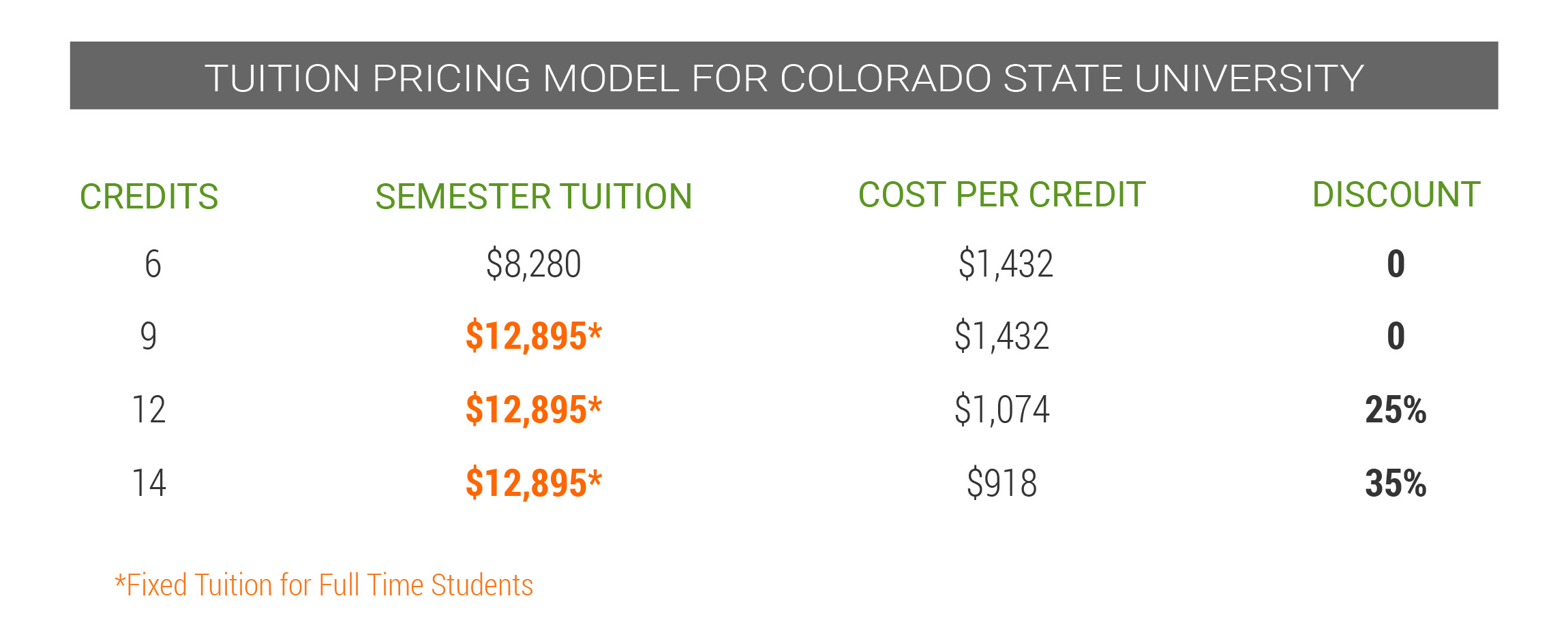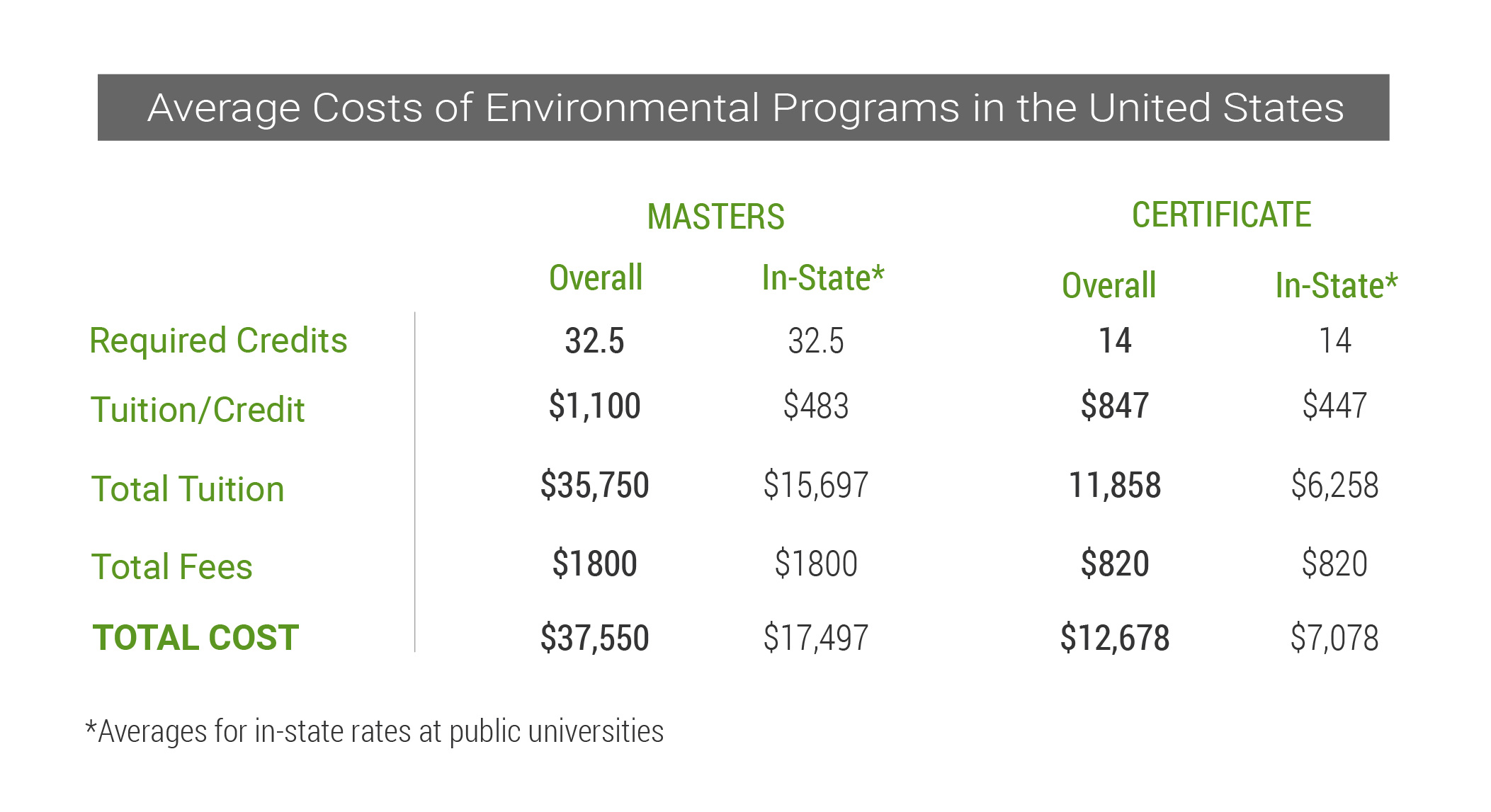How much does graduate school cost? For environmental professionals, this is an especially important question to consider.
In fields like conservation and ecology, an ultra-competitive job market and relatively low pay can make graduate school both critically important and financially questionable at the same time.
If you think you may need to self-fund or secure loans for graduate school, then you should give close consideration to program costs in your decision making.
Why? First of all, understanding the likely costs can help you decide whether or not you should even go to graduate school. You need to know the costs to determine if the benefits of graduate school are worth it.
Second, knowing the costs of different programs can help you comparison-shop and decide which one is best for you.
Understanding the Costs
Most schools publish an official “Cost of Attendance” on their websites. You will see numbers for “Tuition Per Semester,” “Tuition Per Credit,” “Mandatory Fees, and other potentially confusing terms.
Unfortunately, these numbers give an incomplete picture of what your actual program costs will be. To complicate matters, different schools use different pricing approaches. This makes apples-to-apples comparisons difficult.
In the sections to follow, we try to help you better understand the different ways that graduate school pricing works. We also explain how you can translate the prices provided by graduate schools into working estimates of your program costs.
[newsletter-signup]
How do Schools Charge Tuition?
Tuition is the main cost you will pay as a student. If you want to get a good handle on total program costs, you should first look at the tuition numbers. Schools typically charge tuition in one of three ways as outlined below:
Pricing Approach # 1: Tuition Per Credit
Some schools charge tuition on a simple cost per credit basis. For example, Texas A&M charges $903 tuition per credit hour for non-residents.
Estimating Total Program Tuition
Under this pricing model, you can easily estimate your Total Program Tuition costs (i.e. the total tuition you will pay over the duration of your enrollment). Simply take the minimum number of program credits required to graduate and multiply that number by the cost per credit hour. Please note, to figure out your full program cost you will also need to add in the school fees which we review later in this article.

[background_block]
EXAMPLE – Tuition Cost Estimate
Texas A&M’s Wildlife and Fisheries Sciences – MS program
*Requires a minimum of 32 credits to graduate.
$28,896 tuition = 32 credits x $903 per credit
[/background_block]
PRO TIP – Bump your estimates by 15% to buffer for unanticipated costs
When making your estimates you should keep in mind a couple of caveats that could raise your costs. You may want to increase your estimates by 15% to account for these two possibilities:
- If you take more than the minimum number of credits required to graduate, then you will pay more than the estimate. This could easily happen. Maybe you decide to take an extra class to fill in a knowledge-gap or build skills. Maybe your combination of classes goes 1 or 2 credits over the minimum. For a 30 credit program, taking an extra 3 credits will bump your tuition costs 10%.
- Prices can change from year to year. If you are in a 2-year program, the tuition figures for year 1 could go up the second year.
Pricing Approach # 2: Fixed Tuition Per Semester (Full-Time Students)
Many schools charge a fixed tuition cost per semester for full-time students. So what does it take to be a “full-time” graduate student? Generally, if you enroll in 9 credits (or more) in a semester, your school will consider you a full-time student.
For example, Colorado State University charges non-residents a fixed tuition cost of $12,895 for enrolling in 9 credits or more. But it charges $1,432 per credit for enrolling in less than 9 credits.
You Can Save Money by Taking a Heavier Course Load
Under this pricing model, the cost per credit is variable depending on the number of credits you take. See how the cost per credit at Colorado State decreases 25% as a student goes from 9 to 12 credits:

Estimating Total Program Tuition
Estimating your Total Program Tuition under a Fixed Tuition Per Semester model is more complicated and less certain. It depends on how many semesters it takes you to complete your degree and the number of credits you take each semester. This can be hard to predict.
To get a good sense of a typical semester-by-semester course load for a program, contact the department. They should be able to give you the most common scenario. You can then plug in the credits and associated costs for each semester and estimate a total.
There is also a simpler and safer way to calculate your estimate.
Schools with Fixed Tuition Per Semester pricing for full-time students should also have a tuition per credit rate for part-time students. You can take that part-time tuition per credit rate and multiply it by the number of program credits required to graduate.
This “safe” estimate of total tuition may be a little higher than what you would pay with a heavier course load. But it gives a good rough estimate of your total tuition “ceiling.”

[background_block]
EXAMPLE – Estimating Total Tuition with Part-Time Student Rates
Colorado State University’s Wildlife and Fisheries Sciences – MS program
*Requires a minimum of 30 credits to graduate and a Thesis.
*We assume taking no more than 9 credits per semester
*Charges $1,432 per credit for part-time students
$42,960 tuition = 30 credits x $1,432 per credit
[/background_block]
Pricing Approach # 3: Fixed Tuition Per Program
Lastly, some schools use a less common approach of charging a single fixed price for the entire program tuition. You can find this cost structure in some non-thesis, professional- based Master’s programs and Certificate Programs.
The straightforward approach takes the stress out of projecting your program costs.
Tufts University for example charges a flat rate of $44,346 for its 12-month Conservation Medicine – MS program.
Mandatory and Optional Fees
Paying for school means more than just covering the cost of tuition. Schools also charge what are known as “Mandatory Fees.” This term sounds imposing, but it simply refers to fees that you are required to pay.
On the other hand “Optional Fees” typically cover extra niceties like on-campus housing or a dining plan, which you can elect to pay for, or not.
Though they will vary a bit from school to school and program to program, mandatory fees generally help cover extra operational and program expenses.
Below are the mandatory fees at the University of Oregon (Fall 2020).
- Matriculation Fee (one-time) | $430
- Building Fee | $23-$45 (depending on number of credits)
- Incidental Fee | $259.25
- Health Service Fee | $233.25
- Recreation Center Fee | $38
- Technology Fee | $50
[cjbn_cta]
How much will you be paying in mandatory fees?
To arrive at an accurate estimate of your total program costs, you will need to add in your mandatory program fees. These are usually charged on a per-semester basis.
On average, environmental master’s programs listed on CJB Network charge about $450/semester in mandatory fees. However, fees can vary widely from school to school. You should always determine the school fees before estimating program costs. Also, keep in mind that your total fees may depend on how many semesters it takes you to complete your degree.
See how the fees change our cost estimates from earlier. We assume a student completes these programs in 4 semesters:
[background_block]
EXAMPLE – Total Cost with Mandatory Fees
Texas A&M’s Wildlife and Fisheries Sciences – MS program
Estimated Total Tuition = $28,896
Mandatory Fees = $1,744 ($436 per semester)
Total Cost = $30,640
Colorado State University’s Wildlife and Fisheries Sciences – MS program
Estimated Total Tuition = $42,960
Mandatory Fees = $4,520 ($1,130 per semester)
Total Cost = $47,480
[/background_block]
In-State Discounts
You can save a lot of money by attending a public university within the state you live, sometimes paying half the tuition rates that students pay coming out of state. Some schools also participate in regional exchanges that offer discounted tuition to residents of neighboring states.
Most states let you apply for residency after 1-2 years of living within the state. Just make sure you have the proper paperwork for proof of residency when applying to your chosen school. Change your driver’s license, register to vote, have tax documents for your place of work or lease paperwork for your housing.
[background_block]
EXAMPLE – Resident vs. Non-Resident Tuition
See how a resident discount decreases the estimated tuition in the two state schools below:
Texas A&M’s Wildlife and Fisheries Sciences – MS program
Non Resident – Estimated Total Tuition = $28,896
Resident – Estimated Total Tuition = $12,480 (saves 56%)
Colorado State University’s Wildlife and Fisheries Sciences – MS program
Non Resident – Estimated Total Tuition = $42,960
Resident – Estimated Total Tuition = $17,520 (saves 59%)
[/background_block]
PRO TIP – Some online graduate programs offer in-state rates to out-of-state students.
School Tuition Varies Widely
Tuition for environmental graduate programs can vary widely across schools. Below, see two examples on the low and high end of total cost per credit for full-time students.

What is the Average Cost for an Environmental Graduate Program?
Below we outline a range of tuition costs for environmental Master’s and Certificate programs. We calculated these figures from data we gathered on over 1400 environmental graduate programs in the United States that we list on CJB Network.

Total Fees in the table are based on an average of school mandatory fees applied to 4 semesters for a Master’s and 2 semesters for a Certificate.
Other Costs
So far this article has only looked at mandatory tuition and fees charged by schools. However, when considering graduate school, you should also weigh the full costs of the experience including living expenses, books, supplies, and the opportunity cost of any foregone income.
This will help you decide whether graduate school is right for you. It can also help you compare the relative costs of programs.
Living expenses can vary widely across geographic areas. This can have major impacts on the relative affordability of programs. You can use a cost of living tool to estimate your living expenses in multiple geographic locations.
